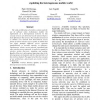362 search results - page 4 / 73 » Separation principles in wireless networking |
PERCOM
2005
ACM
13 years 11 months ago
2005
ACM
Recent developments in pervasive computing have enabled new features for collaboration and instrumentation in educational technology systems. An infrastructure for the integration...
DCOSS
2007
Springer
14 years 6 days ago
2007
Springer
Abstract. We develop a practical, distributed algorithm to detect events, identify measurement errors, and infer missing readings in ecological applications of wireless sensor netw...
TIT
2008
13 years 6 months ago
2008
Interference from other users limits the capacity, and possibly the connectivity, of wireless networks. A simple model of a wireless ad-hoc network, in which node locations are des...
IC
2001
13 years 7 months ago
2001
The wide proliferation of wireless systems and the use of software radio technologies enables the employment of a heterogeneous network. In this concept services are delivered via...
CAIP
2009
Springer
13 years 9 months ago
2009
Springer
Binary decision trees based on univariate splits have traditionally employed so-called impurity functions as a means of searching for the best node splits. Such functions use estim...

